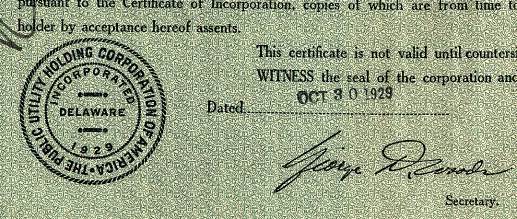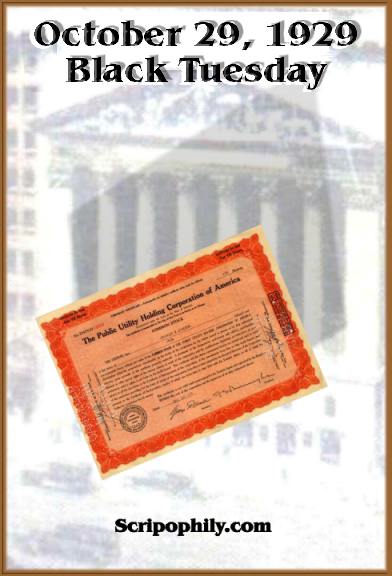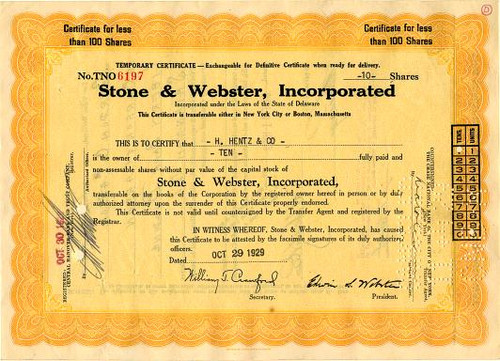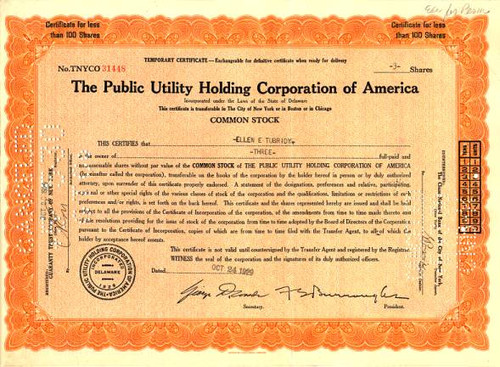Beautifully engraved certificate from the Public Utility Holding Corporation of America issued on October 30, 1929. This historic document was printed by the American Banknote Company and has an ornate border around. This item has the printed signatures of the Company's President and Secretary and is over 86 years old. We have only found a few certificates dated October 30, 1929. Most of the people in the securites business were watching the ticker tape machine the day after the market crash. This certificate was issued to an Eternal Optimist who was hoping the market was coming back! This is one you don't want to miss. 
October 30, 1929 date on Certificate The 1929 stock market crash is conventionally said to have occurred on Thursday the 24th and Tuesday the 29th of October. These two dates have been dubbed "Black Thursday" and "Black Tuesday," respectively. On September 3, 1929, the Dow Jones Industrial Average reached a record high of 381.2. At the end of the market day on Thursday, October 24, the market was at 299.5 -- a 21 percent decline from the high. On that day the market fell 33 points -- a drop of 9 percent -- on trading that was approximately three times the normal daily volume for the first nine months of the year. By all accounts, there was a selling panic. By November 13, 1929, the market had fallen to 199. By the time the crash was completed in 1932, following an unprecedentedly large economic depression, stocks had lost nearly 90 percent of their value. Stocks lost nearly $16 billion in the month of October or 18% of the beginning of the month value. Twenty-nine public utilities (tabulated by the New York Times) lost $5.1 billion in the month, by far the largest loss of any of the industries listed by the Times. The value of the stocks of all public utilities went down by more than $5.1 billion. The 1920s even had an equivalent of today's high flying hard crashing Internet stocks. Shares of RCA, maker of radios and phonographs, soared 400 percent in 1928 alone. But by the middle of 1929, many investors had borrowed so much money that the only way to repay loans was to sell stocks. Prices began to fall, and volume began to escalate as brokers demanded cash to cover their potential losses. The Dow Jones Industrial Average went from a low of 191 in early 1928 to a high of 300 in December, 1928 and peaked at 381 in September 1929. Due to the anticipation of continued increases in earnings and dividends,Price/Earnings ratios rose from a conservative 10 or 12 to 20, and higher for the market's favorite stocks. Many observers believed that stock market prices in the first six months of 1929 were overpriced, while some perceived that stocks were cheap. On October 3, the Dow began to drop, declining throughout the month of October. On Thursday, October 24, 1929, the bottom began to fall out. Prices dropped precipitously as more and more investors tried to sell their holdings. By the end of the day, the New York Stock Exchange had lost four billion dollars, and it took exchange clerks until five o'clock AM the next day to clear all the transactions. By the following Monday, the realization of what had happened began to sink in, and a full-blown panic ensued. Thousands of investors -- many of them ordinary working people, not serious "players" -- were financially ruined. By the end of the year, stock values had dropped by fifteen billion dollars. Many of the banks which had speculated heavily with their deposits were wiped out by the falling prices, and these bank failures sparked a "run" on the banking system. Each failed bank, factory, business, and investor contributed to the downward spiral that would drag the world into the Great Depression. 
This certificate was issued prior to the Public Utility Holding Company Act (PUHCA) cleaning up Public Utility Holding Companies. The Public PUHCA was passed during the Great Depression in response to the failure of a number of utility holding companies and subsequent investor losses. Many investors were defrauded due to information problems peculiar to the holding company structure. The utility holding company structure undoubtedly helped disguise unscrupulous practices, such as the bilking of subsidiaries through service contracts, inappropriate depreciation techniques, and the use of inflated property values, all of which contributed to the collapse of the holding companies. The Public Utilities Holding Company Act (PUHCA) was enacted to eliminate unfair practices and other abuses by electricity and natural gas holding companies by requiring federal control and regulation of interstate public utility holding companies. These abuses arose from the inability of individual states to effectively regulate the financial transactions of multistate and multi-layered utility companies that evolved in the 1910s and 1920s. From the very beginning of the U.S. electric power industry in the late 1800s, technology, economics, and regulations have defined the structure of the industry. At the end of the 1800s, transmission was by direct current (DC), involving large copper conductors. DC power could be transmitted economically only over short distances, requiring generation to be built close to its load. Introduction of a reliable alternating current transmission system in 1903, which provided for long distance transmission at less cost than DC, and the introduction of steam turbine generation technology that was more efficient than reciprocating engines, produced a change of corporate structure. At the same time that economies of scale encouraged utility consolidation, utilities were acquiring increasing numbers of subsidiary companies, some with little or no relation to the utilities' primary business. From 1900 through 1920 the number of private electric systems grew from approximately 2,800 to 6,500. Starting in 1920, the number of private electric systems declined dramatically primarily because of consolidation and pyramiding of utilities through holding companies. Not only did many operating utilities, in diverse parts of the country, come under the control of a small number of holding companies, but those holding companies themselves were owned by other holding companies. As many as ten layers separated the top and bottom of some pyramids. By 1932, three groups controlled 45% of the electricity generated in the United States. Although more than two-thirds of the states had public utility commissions of varying powers by 1920, none of these entities had the economic regulatory power of a modern public utility commission. The state public utility commissions were unable to control the multistate nature of holding companies. Prior to enactment of the Public Utilities Holding Company Act of 1935 (PUHCA), electric and gas holding companies were characterized as having excessive consumer rates, high debt-to-equity ratios, self-dealing, and increasingly unreliable service. A holding company parent was able to charge its associated utilities exorbitant amounts for services, such as construction of facilities, fuel supply, or billing. Excessive fees charged to operating companies were passed through to consumers as higher rates. Holding companies incurred increasing amounts of debt to finance their interests in a growing number of subsidiaries. The economics of generating and transmitting electricity had changed dramatically since 1900. Economies of scale were not been taken advantage of and the marginal costs (the cost of each additional unit of generation) were less than average cost. The classic monopoly situation existed. Most highly leveraged holding companies that managed to stay solvent during the prosperous 1920s collapsed after the stock market crash because they could not service their debt. Lower demand for electricity resulted in inadequate revenue to meet fixed obligations. As more and more companies went bankrupt, service deteriorated. While there were advantages to the holding company structure, holding company abuses became apparent after the stock market crash in 1929 when investors lost millions of dollars. During the seven-year period between 1929 and 1936, 53 holding companies with combined securities of $1.7 billion went into bankruptcy or receivership. Twenty-three others were forced to default on interest payments or to offer extension plans. In 1928, the Federal Trade Commission issued a report that listed the abusive practices of holding companies. It concluded that the holding company structure was unsound and "frequently a menace to the investor or the consumer or both." As noted earlier, holding companies operated with no federal and little state regulation. The state utility commissions lacked sufficient authority and resources to control holding companies because companies operated generally in many states and had extremely complex structures. The federal government decided regulatory action was required. The Federal Power Act, which established a federal utility regulatory system, was enacted at the same time as the Public Utility Act of 1935(4); these two Acts were intended to work in tandem. Title I of the Public Utility Act of 1935 is known as the Public Utilities Holding Company Act of 1935 (PUHCA). PUHCA was enacted to eliminate unfair practices and other abuses by electricity and gas holding companies by requiring federal control and regulation of interstate public utility holding companies. A regulatory bargain was created between utilities and the government. In exchange for an exclusive service territory, utilities are required to provide reliable electric service to all customers at a regulated rate. A holding company under PUHCA is an enterprise that directly or indirectly owns 10% or more of stock in a public utility company. To eliminate the complex and confusing structure of holding companies that had made them almost impossible to regulate, Section 11b of Title I (the "Death Sentence Clause") of PUHCA abolishes all holding companies that were more than twice removed from their operating subsidiaries. All electric and natural gas holding companies are required to register with the Securities and Exchange Commission (SEC). Under PUHCA, the SEC regulates mergers and diversification proposals of holding companies whose subsidiaries engage in retail electricity or natural gas distribution. In addition, PUHCA requires that before purchasing securities or property from another company, a holding company must file for approval with the SEC. Other major sections of PUHCA provide that: registered holding companies and their subsidiaries must have SEC approval prior to issuing securities; operating utilities are forbidden from making loans to their parent holding company; all loans and intercompany financial transactions are regulated by the SEC; the operations of non-exempt holding companies are limited to single and integrated public utility systems and to such businesses that are reasonably incidental or economically necessary or appropriate to the operations of such integrated systems; and, non-exempt holding companies that are subject to SEC regulation must maintain certain accounts and records, which are subject to SEC review. The SEC does allow companies to operate in several areas if this preserves the economy of operation, or if the areas are located in a single state, adjoining states, or contiguous foreign country, and providing that the creation of such a holding company does not inhibit efficient operation or effective regulation.

October 30, 1929 date on Certificate









